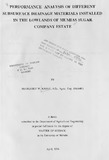| dc.description.abstract | The Murnias Sugar Company (MSC), which is the study area, has a nucleus estate measuring
over 3,000 ha. These comprise 2,527 ha of well drained uplands and 870 ha of poorly
drained lowlands. The poorly drained lowlands were of interest to this study.
An experimental subsurface drainage system was designed and installed in these lowlands.
The experimental set up consisted of different drainage materials applied as five treatments
in three replicates. The experimental design used was a randomised complete block design.
The treatments applied were perforated PVC pipes, porous concrete drains, loose rock filled
French drains, bagasse filled drains and a control, without any drains. The first three drains
had been wrapped in pol yfelt as a filter material.
This study was carried out with the aim of establishing the overall effectiveness of the
drainage materials as far as commercial sugarcane growing is concerned, and thus making
recommendations on the material to be adopted for the lowland sugarcane fields.
Performance analysis was carried out through the analysis of data collected on water table
depths, drain discharge, and crop response data (yields and other crop parameters).
Perforated PVC and porous concrete drains functioned efficiently lowering the water table
fast and to relatively low depths (up to 150 ern +). Bagasse filled drains did not perform as
well as the PVC or concrete drains, while the performance of the rock filled French drains
was relatively poor. Cane yields obtained were good for all treatments, being in most cases
higher than the expected yield for the variety (95 - 115 t/ha). Other crop response parameters
also had relatively high values. Differences observed in the various cane response data were
however not statistically significant. This could be explained by the fact that the experiment
<l>
went through a dry spell that occurred in the region shortly after planting. The cane in all
treatments thus experienced approximately similar drainage conditions in the initial stages of
the crop's establishment. This is also the critical period for sugarcane as far as drainage is
concerned.
From the cane and sugar yield stand point, therefore, there appears to be no advantage
among the various treatments. This meant that no materials could be justifiably recommended
for adoption at this stage. Further monitoring of the experiment was found necessary in order
to sample an adequate range of crop / seasonal weather variation interaction. | en |

